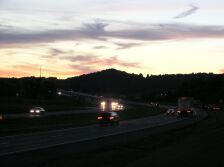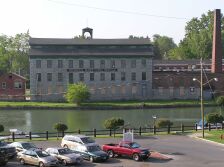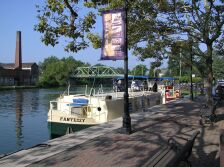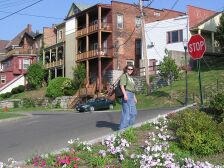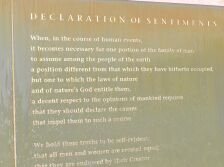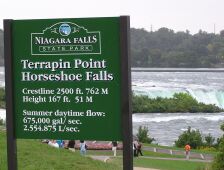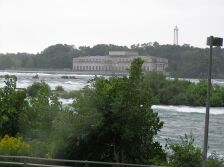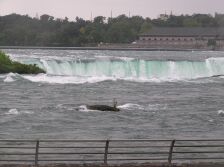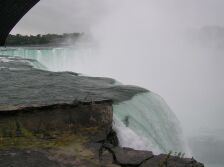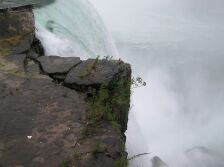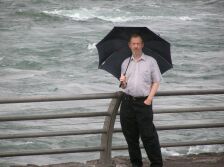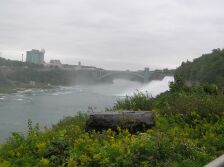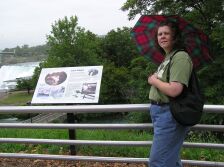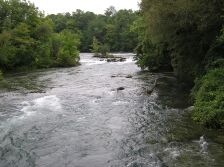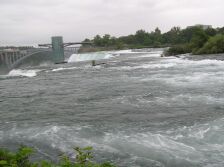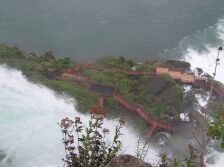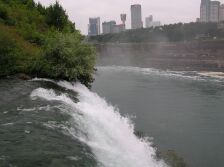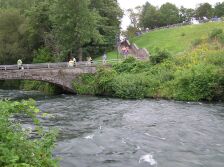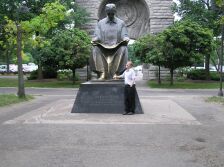Worldcon 2004 - Seneca Falls and Niagara Falls
|
After the convention we got into the car and drove off into the sunset. This was made even more cinematic by the large fireworks display we saw from the highway. But as night fell we were forced to face the harsh realities of finding lodging and high speed internet access. |
|
|
...which we found in Seneca Falls. The main problem with Seneca Falls is that there are no falls since they were improved out of existence years ago. There were, however, still a lot of relics (like this mill) around from those days when water power was king. |
|
|
Another holdover from an earlier century was the canal boat. Like in Great Britan these boats are rented to brave tourists who want to seek adventure on the old canals. And like in the case of a certain trip by Dermot and company this boat was tied up by engine trouble – the crew of this boat didn't have Marinna but they had cell phones and knew how to use them. |
|
|
After breakfast Amy sets out to explore the birthplace of Women's Lib. Nice little town but there didn't seem to be a lot going on (though traffic was heavy). |
|
|
Amy stands in front of the site of First Women's Rights Convention in America. The place is a little strange since the hall itself isn't there any more and a lot of pink granite is. But like many other places it's what happened there that counts and not what the place looks like. |
|
|
And this is what makes this place important. The "Declaration of Sentiments" are inscribed here under a wall of water (heavy symbolism here) and are basically the declaration of independence of the Womens' Movement. To read the whole thing click here. |
|
|
Then from Seneca Falls to Niagara Falls. These falls are still there though they can be turned off at will and there are treaties that determine exactly how much water goes over the falls. |
|
|
Where does the rest go? Well, the power houses (this one on the Canadian side) use a good bit to produce power. This one is located above the Falls but there are some below also. Basically the water goes through tunnels that bypass the actual falls and somewhere along the line there is a turbine that converts the water flow into electricity. |
|
|
There's still a lot of water left to go over the falls, though. The width of the Falls is quite impressive, perhaps even more than the height. Note another power house in the background. |
|
|
Because they are so wide the water is quite shallow at the point where it goes over the edge. If the water were not flowing quite so fast it might be possible to walk across... |
|
|
On the other hand the rock looks a little on the crumbly side. |
|
|
Even if it weren't raining the mist from the Falls makes raingear a useful accessory. |
|
|
Looking east we see that the US does not have a monopoly on tackiness or kitsch. It seems that the Canadians have more (or at least bigger) hotels – we, on the other hand, have a choice selection of industrial ruins. |
|
|
A better look at the American Falls. All the pictures so far have been taken from Goat Island which lies between the Canadian (Horseshoe Falls) and American Falls. |
|
|
At the tip of Goat Island is Luna Island where, back in the good old days before electric lights, you could see moonbows. These days we have to content ourselves with rainbows or, as Amy is discovering, just plain rain. |
|
|
This is the little channel that seperates Goat Island from Luna Island. Looking to the west it doesn't look too bad. Might even be fun to canoe. |
|
|
On the other hand if we look east we quickly change our minds... |
|
|
...too bad it is too late and we are swept to our doom. The walkways we see (as we fall) are where you end up if you take the "Cave of the Winds" tour. You can see why you need raincoats for this tour. |
|
|
As we look back toward the west and Goat Island we see the Canadian side and yes, near the water, yet another power house. |
|
|
The bridge back to Goat Island. |
|
|
No trip to Niagara Falls is complete without a visit to the statue of Nikola Tesla. If you don't know who he was you can thank the Edison propaganda machine. The reason his statue is here is that he designed the system that got the power from Niagara’s powerhouses to New York City and continues to deliver electrical power all over the world today. |
